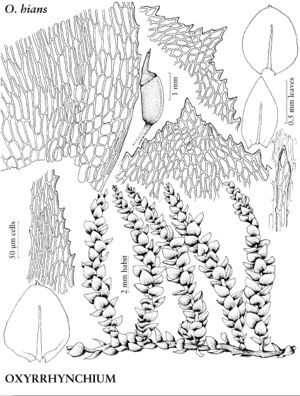Oxyrrhynchium
Krypt.-Fl. Brandenburg 2: 781. 1905.
| Taxon | Illustrator ⠉ | |
|---|---|---|
 | Oxyrrhynchium hians | Patricia M. Eckel |
Plants medium-sized, in loose tufts, light green to whitish or brownish. Stems creeping to arching, loosely, occasionally more densely terete-foliate, julaceous or not, irregularly or sometimes regularly branched, branches terete, subcomplanate, or sometimes distinctly complanate-foliate, especially when leaves remote; central strand present; pseudoparaphyllia acute; axillary hairs of 2 or 3 cells. Stem-leaves erectopatent to patent, loosely arranged to occasionally loosely imbricate, broadly ovate to ovatelanceolate, slightly to moderately strongly concave, not plicate; base narrowly short-decurrent; margins serrate to serrulate; apex gradually tapered to acute, long or short-acuminate; costa to 50–70% leaf length, broad throughout, terminal spine present, sometimes with additional teeth abaxially; alar cells enlarged; laminal cells elongate, walls moderately thick; basal juxtacostal cells shorter, slightly broader. Branch leaves slightly to strongly differentiated, if strongly differentiated then more elliptic, broadest at 1/3–1/2 leaf length, twisted mid leaf; base often asymmetric; apex more shortly acuminate to acute; costa more strongly toothed distally, terminal spine more stout; laminal cells not or occasionally prorate. Sexual condition dioicous; perichaetial leaf acumen long, reflexed. Seta redbrown, rough. Capsule inclined to horizontal, redbrown, elongate, curved; annulus separating in fragments; operculum short-conic, narrowly long-rostrate; peristome xerocastique, perfect. Calyptra naked. Spores 10–13 µm.
Distribution
Nearly worldwide, absent in cold boreal regions
Discussion
Species 10–15 (1 in the flora).
The segregation of Oxyrrhynchium from Eurhynchium was initially accepted by many authors, including V. F. Brotherus (1924–1925). However, the species were later placed back into Eurhynchium (for example, H. Robinson 1962; H. A. Crum and L. E. Anderson 1981). The phylogenetic analysis by M. S. Ignatov and S. Huttunen (2002) demonstrated that Eurhynchium in the broad sense is polyphyletic, and Oxyrrhynchium belongs to a subfamily different from Eurhynchium in the strict sense. Oxyrrhynchium is distinct in having a rough seta (smooth in Eurhynchium), and a tendency for subcomplanate foliage, but this is not observed in Eurhynchium. Aquatic species closely related to Oxyrrhynchium are treated as Donrichardsia (Huttunen et al. 2006).
Selected References
None.
Lower Taxa
"long" is not a number."broadest" is not a number."broad" is not a number."broad" is not a number.